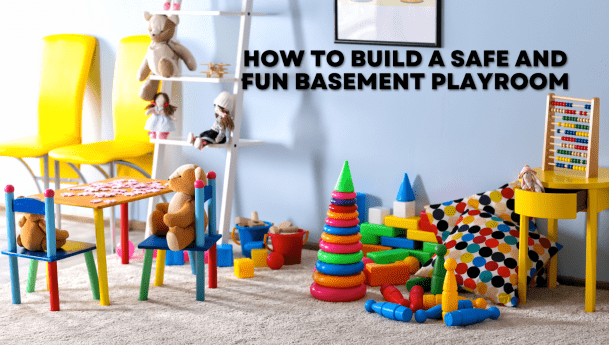
As a parent or guardian, one of your top priorities is creating a safe and nurturing environment for your little ones to explore, imagine, and thrive. When designing a playroom, safety is a top priority for most parents. Transforming your basement into a dedicated play space can be an exciting yet daunting task, but it’s a good idea.
This comprehensive guide will walk you through the essential steps to create a basement playroom that seamlessly blends safety, functionality, and boundless fun. From selecting the right furniture to incorporating eco-friendly materials, we’ve got you covered with expert insights, practical tips, and inspiration to unlock your child’s creativity.
Remodeling Basement as Playroom for Kids
Living in Naperville gives you an added advantage of a sophisticated living and a small town warmth. Naperville has been recognized nationally and internationally as one of the top communities in which to settle down, raise a family, and retire. It has made headlines for its outstanding quality of life. According to SafeWise’s report on America’s Safest Cities to Raise a Child report, Naperville was ranked on top for being the safest city in the US.
Your basement holds untapped potential, ready to transform into whatever your heart desires—be it a cozy guest suite, a fun media room, or a productive home office. Remodeling a basement requires careful planning and execution to transform the space into a functional and inviting area of your home. This typically begins with thorough planning and design, where you determine the purpose of the basement and create a floor plan that meets your needs. Naperville basement remodeling typically begins with thorough planning and design, where you determine the purpose of the basement and create a floor plan that meets your needs. Before proceeding, it’s crucial to check local building codes and obtain any necessary permits.
Choosing the Right Furniture
Furniture choices in a playroom go beyond aesthetics—they play a crucial role in ensuring your child’s safety and comfort. Most parents prefer multi-purpose furniture in a playroom for its comfort and functionality, so look for pieces that serve multiple purposes without compromising on sturdiness or edges that could pose a risk.
Bean bags, soft seating options, and storage ottomans are excellent choices that provide both comfort and versatility. Always prioritize furniture made from non-toxic materials and free from sharp corners or edges that could harm your little explorer.
Pro Tip: Consider investing in modular or reconfigurable furniture pieces that can adapt to your child’s changing needs and interests over time.
Selecting Playful Colors
Colors have a profound impact on a child’s mood, behavior, and overall development. Bright, stimulating hues like vibrant reds and sunny yellows can energize and encourage physical activity, while softer pastels like soothing blues and gentle greens can create a calming, relaxed ambiance.
Don’t be afraid to mix and match colors to create a vibrant, visually engaging space. You can even use color to define different play areas, such as a reading nook or a creativity corner. Remember, the playroom should be an extension of your child’s imagination, so let their interests guide your color choices.
Incorporating Learning Spaces
While playtime is essential for physical and social development, it’s equally important to nurture your child’s cognitive growth. 85% of parents believe educational toys are crucial for their child’s development, so incorporate dedicated learning spaces within your basement playroom.
Create a cozy book nook with a plush rug, bean bag chairs, and a well-stocked bookshelf. Encourage problem-solving and creativity with interactive puzzles, building blocks, and age-appropriate educational games. By blending learning and play, you’ll foster a love for knowledge and discovery in your little one.
Insider Tip: Rotate toys and educational materials regularly to keep the learning experience fresh and engaging for your child.
Storage Solutions
A cluttered playroom can quickly become a safety hazard and a source of stress for both you and your child. Parents agree that organized storage is essential for a child’s playroom, so plan for ample storage solutions from the start.
Incorporate toy bins, shelves, cubbies, and chests to keep everything in its place. Encourage your child to participate in clean-up routines by making the storage system accessible and easy to use. Consider washable materials for storage units, as they’ll inevitably face spills and messes.
Handy Tip: Label storage bins with pictures or words to help your child learn organization skills while tidying up.
Flooring and Wall Considerations
The right flooring and wall choices can significantly enhance the safety and functionality of your basement playroom. For younger children, 80% of parents prefer plush carpet or foam mat flooring, which provides a soft landing surface for those inevitable tumbles and falls.
Consider transitioning to hardwood or laminate flooring for durability and easy cleaning as your child grows older. When it comes to walls, explore built-in furniture options like cubbies and shelves to maximize storage and create an efficient use of space.
Safety Measures
Safety should always be the top priority when designing a playroom. Ensure your basement has an emergency exit that is easily accessible and clearly marked. Install safety gates to prevent access to hazardous areas, and cover electrical outlets to eliminate potential shock risks.
Consider setting up a video camera or baby monitor for added peace of mind, allowing you to keep an eye on your little one while they play. 70% of parents use safety gates and cover electrical outlets in their child’s playroom, ensuring a secure and worry-free environment.
Safety First: Safety First: Always supervise young children in the playroom and keep hazardous materials, such as small toys or loose parts, out of reach.
Lighting and Ventilation
Proper lighting and ventilation are essential for creating a comfortable and healthy playroom environment. A combination of overhead and task lighting will ensure adequate illumination for various activities, while good ventilation will maintain air quality and prevent musty odors.
Consider installing windows or skylights to allow natural light and fresh air into the space. If windows are not an option, invest in high-quality air purifiers and energy-efficient lighting fixtures.
Eco-Friendly Materials
As parents, we want to create a healthy and sustainable environment for our children to thrive. For good reason, 65% of parents prefer using natural, sustainable materials in their child’s playroom.
Opt for cotton rugs, cork flooring, and low-VOC paints to minimize exposure to harmful chemicals. Salvaged or recycled materials can add character and charm while promoting eco-consciousness. By choosing eco-friendly options, you’ll create a safe, long-lasting playroom that aligns with your values.
Pro Tip: Involve your child in the design process by letting them choose eco-friendly materials or repurposed decor items for the playroom.
FAQs
- How can I keep the playroom organized?
Implement a variety of storage solutions, such as bins, baskets, and shelves, to encourage organization. Involve your child in the clean-up process by using labeled containers and making it a fun routine. Additionally, consider furniture pieces that double as storage to maximize space efficiency.
- What are some tips for making the playroom safe for children of all ages?
Prioritize furniture without sharp edges, secure furniture to walls to prevent tipping, and cover electrical outlets. For younger children, opt for soft flooring like mats or plush carpets to cushion falls, and install safety gates to restrict access to hazardous areas.
- How can I ensure the playroom is fun and engaging for my child?
Incorporate a variety of colors, themes, and educational toys that align with your child’s interests. Designate areas for different types of play, such as a book nook, arts and crafts corner, or building zone. Rotating toys and changing the layout periodically can also keep the space fresh and exciting.
An Enduring Space for Growth and Imagination
Creating a basement playroom that is both safe and fun is an investment in your child’s development and well-being. By thoughtfully considering furniture choices, color schemes, educational elements, storage solutions, safety measures, and eco-friendly materials, you’ll craft a nurturing environment that fosters creativity, curiosity, and endless hours of joy.
Remember, the key is to strike a balance between functionality and whimsy, ensuring your child’s playroom is a space where they can grow, learn, and let their imaginations soar.
So, why wait? Unleash your inner designer and create the ultimate basement playroom—a haven where cherished memories are made and childhood dreams come to life.



